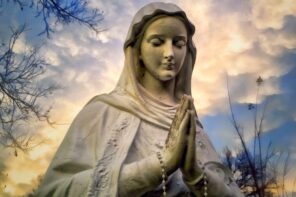For three months, the city of Windsor, Ontario was abuzz with the story of a Virgin Mary statue that wept tears of oil. Ensconced in a small shrine built on Fadia Ibrahim’s front lawn, the statue attracted hundreds of pilgrims, though it caused havoc for neighbors, city officials, and Church authorities.
Miraculous images of the Virgin Mary, part of a tradition commonly known as “folk piety,” exist independently of any religious authority, and the fervor generated is sometimes too much for the Church—or anyone—to control. In this most recent case the attention eventually overwhelmed the statue’s owner, such that, on November 5, in order to protect the privacy of her family, she had the statue relocated to St. Charbel Maronite Catholic Church. In fact, the Virgin told her she would prefer pilgrims visit her in church rather than on Ibrahim’s front lawn.
Ibrahim was a Marian seer long before the arrival of the statue. Her first message from the Virgin Mary came about two years ago when, sitting in mass, a cross and the letter ‘M’ appeared in blood on her leg. Since then, the Virgin has inscribed other messages on her body and has even spoken to her directly. Ibrahim’s message from Mary is that people must invigorate their faith and return to church.
Catholic tradition has a long history of Marian seers. Typically, Mary appears to deliver jeremiads about the state of the world and the Church; in 1846, for example, Mary warned two children at La Salette, France, that too many Catholics were eating meat during Lent; during the Russian Revolution in 1917, she appeared to children in Fatima, Portugal, who were shown a vision of hell and warned that Russia must be consecrated to Mary’s immaculate heart; in the 1970s, Veronica Lueken of Bayside, New York, expressed Mary’s condemnation of abortion and warned that the world would soon be punished with a fiery ball from space.
While seers can be men, they have stereotypically been young girls and nuns. Since 1950, however, there have been several prominent seers in North America who, like Ibrahim, have children of their own. Ibrahim is also unusual in that she is Orthodox, not Catholic. But this hardly matters to the subculture of people who follow Marian apparitions and prophesies. It was Catholic supporters in nearby Detroit who sent Ibrahim the statue and, later, the money for her to construct an enclosure so that pilgrims could admire it from her front lawn.
Marian seers, apparitions, and other miracles have appeared all over the world and appear to be on the rise, particularly since the close of the Second Vatican Council in 1965 which, ironically, had sought to rein in Catholic folk piety. The surge continued for the remainder of the century, buoyed by expectations about the coming millennium. Dedicated lay organizations have formed around the most prominent sightings and hundreds of websites are devoted to interpreting Marian prophecies.
Generally, the Church is dubious of such claims. Only a handful of apparitions have met the Church’s standards for approval and even this has been conditional. Major sightings in places like Lourdes and Fatima have been deemed “worthy of belief”—meaning that their veracity is not a point of Catholic doctrine—but that there’s no harm if Catholics choose to believe them. Other seers like Veronica Lueken, Mary Ann Van Hoof of Necedah, Wisconsin, and Nancy Fowler of Conyers, Georgia, have been soundly condemned for their radical and apocalyptic prophecies.
But the fact is, many Catholics could care less whether their favorite Marian apparition receives approval from the Vatican. After all, what right do Church authorities have to challenge the Queen of Heaven? Frequently, Marian piety actually serves as an outlet for ideas that the Catholic hierarchy is resistant to. Mary has always served as an important expression of the sacred feminine, a counter-balance to the patriarchal authority of God and his son. While the Catholic Church does not ordain women, Marian seers wield the authority of charisma. In some cases, seers have even challenged priests and bishops.
Marian piety can also serve as an outlet for end-time prophecies. While Jesus is the central figure of Protestant millennialism, when lay Catholics suspect the world might be ending they turn to Mary. Ibrahim has never preached of a coming catastrophe, but pilgrims agree that Mary’s arrival in Windsor signifies dark times. One visitor commented, “Seeing is believing, and definitely we do see her weeping—weeping for the world, weeping because there’s no love left in this world.” Another added, “I watch the news and I can’t help but be saddened by what I see, but how much more for this woman? This is a woman who watched her own son die on a cross. Now she’s weeping for us because we’re killing this world.”
In some cases, Church authorities who speak out against popular seers are seen as complicit in “killing the world.” Lueken and Van Hoof famously accused Church officials of being communist infiltrators. While the Orthodox Church is not as well known for Marian apparitions, Father John Ayoub of the St. Ignatius of Antioch Church appears to be using a strategy similar to that of Catholics authorites, trying to find a delicate balance between uncritical acceptance and stark condemnation. Father Ayoub remarked that he had investigated Ibrahim’s weeping statue and that while it was not miraculous, Ibrahim was still a beloved member of his parish. He added, “If you want to believe [Ibrahim], you are free to believe her.” However, for some pilgrims, Father Ayoub’s answer simply isn’t good enough. At least one woman, who managed to get his unlisted number, screamed at him demanding that he confirm the miracle.
While Marian apparitions always bring controversy, this is especially so in urban areas where neighbors rarely appreciate pilgrims blocking traffic and saying the rosaries at all hours of the night. City officials responded by noting that the statue’s enclosure, which was built without a permit, did not meet building codes. Ibrahim was given until November 19 to remove both the statue and enclosure. Initially, she vowed to defy the order starting a petition and collecting donations for a legal battle.
However, on November 5, she changed her mind as being in the center of the controversy was placing too great a strain on her family. Besides, Mary herself asked to be relocated. Mary’s stated purpose in appearing in Windsor after all was to get people to return to church and besides, it would perhaps be out of character for Mary, “The Mother of Perpetual Help,” to place unnecessary strain on a mother and her family. It will be interesting to see if Fadia’s statue continues to weep oil in its new home or whether the miracles of folk piety can only occur outside the walls of the Church.




